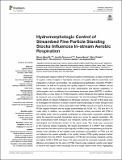Por favor, use este identificador para citar o enlazar a este item:
http://hdl.handle.net/10261/248561COMPARTIR / EXPORTAR:
 SHARE
BASE SHARE
BASE
|
|
| Visualizar otros formatos: MARC | Dublin Core | RDF | ORE | MODS | METS | DIDL | DATACITE | |

| Título: | Hydromorphologic Control of Streambed Fine Particle Standing Stocks Influences In-stream Aerobic Respiration |
Autor: | Meredith, Warren CSIC ORCID; Drummond, Jennifer D. CSIC ORCID ; Bernal, Susana CSIC ORCID ; Tobella, M.; Ribot, Miquel CSIC ORCID; Schumer, Rina; Sabater, Francesc CSIC ORCID; Martí, Eugènia | Fecha de publicación: | 2021 | Editor: | Frontiers Media | Citación: | Frontiers in Water : doi:10.3389/frwa.2021.682905 (2021) | Resumen: | Fine particulate organic matter (FPOM) accumulated in streambeds is a major component of organic matter budgets in headwater streams and greatly affects productivity and metabolism of stream communities. The spatiotemporal distribution of benthic FPOM in the stream, as well as its quantity and quality, depend on inputs from different source types. These can be natural such as soils, streambanks and riparian vegetation, or anthropogenic such as effluents from wastewater treatment plants (WWTP). In addition, stream flow is a key driver of FPOM dynamics, which influences the balance between its transport and accumulation in the streambed. Yet, the link between FPOM dynamics and its effects on stream metabolism is still largely unknown. The aim of this study was to investigate the influence of stream channel hydromorphology on water transport and streambed accumulation of fine particulate matter (FPM) (mineral and organic fractions), FPOM (organic fraction) and its quality (characterized by %OM, %C, %N and the C:N molar ratio). In addition, we quantified the metabolic activity associated with FPM at the habitat scale, and its potential contribution to whole-reach ecosystem respiration using the resazurin-resorufin bioreactive tracer as a proxy for aerobic respiration. We also characterized water transport and metabolic activity with combined additions of hydrological and bioreactive tracers at the reach scale. The study was conducted in the Cànoves stream (Catalonia, NE Spain) downstream of a WWTP that contains three reaches that were hydromorphologically modified using bioengineering techniques. Slower local velocities at the habitat scale increased accumulation of FPM, but did not influence the spatial variability of its quality. Instead, FPM quality declined further downstream from the WWTP. Accumulation of FPM did not increase metabolic activity, but higher %OM of FPM and lower C:N ratios favored the microbial metabolic activity efficiency (normalized by the gram of FPM). Reach-scale metabolic activity was higher in reaches with higher water exchange rate and longer relative travel times, highlighting hydromorphology as an important driver of microbial metabolic activity at the reach-scale. This demonstrates that the interplay of hydrologic exchange and residence time in streambed sediments associated with the microbial metabolic activity of FPOM can ultimately influence reach-scale metabolic activity. | Descripción: | Este artículo contiene 13 páginas, 4 figuras, 2 tabals. | Versión del editor: | https://doi.org/10.3389/frwa.2021.682905 | URI: | http://hdl.handle.net/10261/248561 | ISSN: | 2624-9375 |
| Aparece en las colecciones: | (CEAB) Artículos |
Ficheros en este ítem:
| Fichero | Descripción | Tamaño | Formato | |
|---|---|---|---|---|
| Meredith 2021.pdf | 1,45 MB | Adobe PDF |  Visualizar/Abrir |
CORE Recommender
Page view(s)
102
checked on 13-may-2024
Download(s)
78
checked on 13-may-2024
Google ScholarTM
Check
NOTA: Los ítems de Digital.CSIC están protegidos por copyright, con todos los derechos reservados, a menos que se indique lo contrario.
